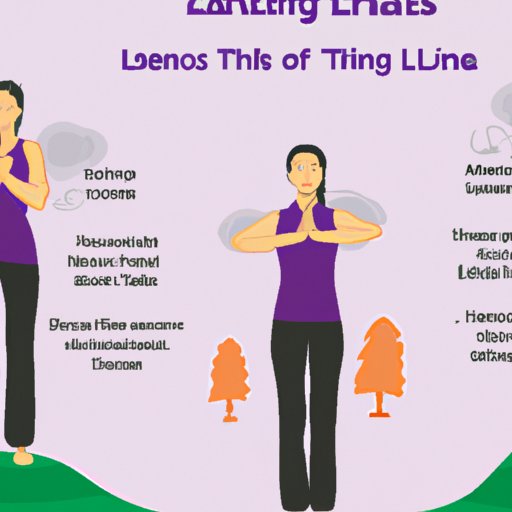Introduction
Lung health is an important component of overall health and wellness. From asthma and COPD to lung cancer, it’s important to take care of your lungs in order to maintain a healthy lifestyle. Fortunately, there are several ways to exercise your lungs and keep them functioning at their best. In this article, we’ll explore some of the most effective methods for exercising your lungs, including deep breathing exercises, yoga poses, cardio workouts, and breathing techniques. We’ll also discuss the importance of avoiding polluted areas and provide tips for limiting time spent in such areas.
Lung Expansion Exercises
Deep breathing exercises are one of the most common and effective ways to exercise your lungs. These exercises help to expand the capacity of your lungs and strengthen the muscles used for respiration. According to a study published in the journal Respiratory Care, “Breathing exercises can increase the functional residual capacity (FRC) by expanding the chest wall and increasing the displacement of the diaphragm, thus improving the ventilation/perfusion ratio in the lungs.”
To perform deep breathing exercises, start by sitting in a comfortable position with your back straight and your shoulders relaxed. Take a deep breath in through your nose, filling your lungs from the bottom up. Hold your breath for a few seconds before slowly exhaling through your mouth. Repeat this process five to ten times. You can also focus on specific parts of your lungs when performing these exercises, such as inhaling deeply into your lower lungs and exhaling completely from your upper lungs.
Yoga Poses
Yoga poses are another great way to exercise your lungs. Certain yoga poses are specifically designed to open and expand your respiratory system, allowing for deeper and more efficient breathing. These poses also help to strengthen the muscles used for respiration, which can reduce fatigue and improve overall lung function.
Examples of yoga poses that focus on respiration include cobra pose, bridge pose, and shoulder stand. To perform cobra pose, lie on your stomach and place your hands beneath your shoulders. Slowly press your body up off the ground, arching your back and opening your chest. Hold this pose for five to ten breaths before releasing back to the floor. Bridge pose can be done by lying on your back and pressing your feet into the ground. Lift your hips off the ground and hold for five to ten breaths. Shoulder stand can be done by lying on your back and using your arms to support your body as you lift your legs off the ground. Hold this pose for five to ten breaths before lowering your legs back down to the ground.
Cardio Workouts
Incorporating cardio workouts into your fitness routine is another great way to exercise your lungs. Activities such as running, biking, and swimming can help to increase your lung capacity and improve your overall respiratory health. A study published in the journal Exercise Medicine found that regular aerobic exercise was associated with improved lung function, reduced airway inflammation, and improved exercise performance.
Examples of cardio exercises that can be incorporated into a fitness routine include running, cycling, swimming, and rowing. Try to incorporate at least 30 minutes of cardio exercise into your routine three to four days per week. Aim for higher intensity workouts such as interval training or HIIT to maximize the benefits for your lungs.
Breathing Techniques
Mindful breathing techniques are another great way to exercise your lungs. Diaphragmatic breathing, also known as belly breathing, helps to improve the efficiency of your respiratory system by teaching you how to breathe deeply and fully. Pursed-lip breathing is another technique that can help to reduce shortness of breath caused by asthma or other lung conditions. It involves breathing in slowly through your nose and out through pursed lips as if you are blowing out a candle.
To practice diaphragmatic breathing, start by lying on your back with one hand on your chest and the other on your stomach. Take a deep breath in through your nose, feeling your stomach rise as your lungs fill with air. Hold your breath for a few seconds before slowly exhaling through your mouth. Focus on pushing all of the air out of your lungs as you exhale. Repeat this process five to ten times.
Avoid Polluted Areas
In addition to exercising your lungs, it’s important to avoid areas with high levels of air pollution. Air pollution has been linked to a variety of respiratory illnesses, including asthma, COPD, and lung cancer. A study published in the journal Environmental Health Perspectives found that long-term exposure to air pollution was associated with increased risk of mortality from cardiopulmonary diseases.
If you live in an area with high levels of air pollution, it’s important to limit the amount of time you spend outdoors. Wear a mask when you go outside and try to stay away from busy roads and highways. Additionally, you can install air purifiers in your home to reduce the amount of pollutants in the air.
Conclusion
Exercising your lungs is an important part of maintaining good respiratory health. Incorporating different types of exercise into a fitness routine can help to improve your lung capacity and reduce the risk of respiratory illnesses. Deep breathing exercises, yoga poses, cardio workouts, and mindful breathing techniques can all help to exercise your lungs. It’s also important to avoid polluted areas and limit the amount of time you spend outdoors in such areas.
By following these tips, you can ensure that your lungs remain healthy and functioning at their best. Regular exercise and mindful breathing can help to improve your quality of life and reduce the risk of developing respiratory illnesses.
(Note: Is this article not meeting your expectations? Do you have knowledge or insights to share? Unlock new opportunities and expand your reach by joining our authors team. Click Registration to join us and share your expertise with our readers.)
